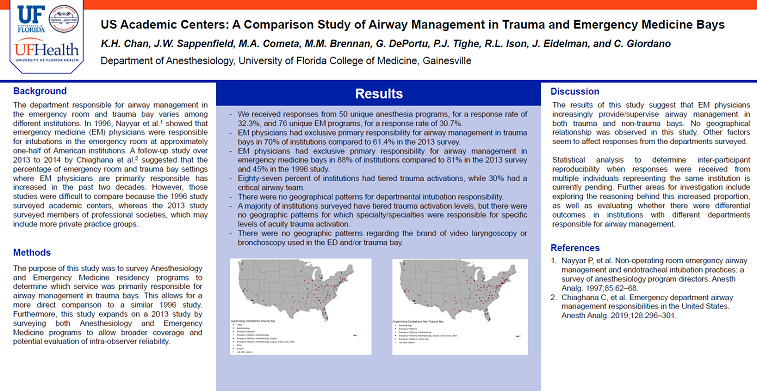2021 FSA Posters
P019: NATIONAL SURVEY TO INVESTIGATE AIRWAY MANAGEMENT IN TRAUMA BAYS AND EMERGENCY MEDICINE BAYS AT ACADEMIC CENTERS
K H Chan; J W Sappenfield; M A Cometa; M M Brennan; G DePortu; P J Tighe; R L Ison; J Eidelman; C Giordano; Departments of Anesthesiology and Emergency Medicine, University of Florida College of Medicine, Gainesville, FL
Background: The responsibility for airway management in the emergency room and trauma bay varies amongst different institutions. In 1996, Nayyar et al. (1) showed that emergency medicine (EM) physicians were responsible for intubations in the emergency room at approximately half of United States’ institutions. A follow-up study in 2013-14 by Chiaghana et al. (2) suggested that the percentage of emergency room and trauma bay settings where EM physicians are primarily responsible has increased in the past two decades. However, those studies were difficult to compare because the 1996 study surveyed academic centers, while the 2013 study surveyed members of professional societies which may include more private practice groups.
Objective: The purpose of this survey is to evaluate which department was primarily responsible for intubations in trauma bays specifically at academic centers in the United States, thus allowing for a more direct comparison to the 1996 study. Furthermore, this study expands on the 2013 study by surveying both Anesthesiology and Emergency Medicine programs and across a broader, more balanced geographical distribution to evaluate for any patterns of systematic perceptions amongst a given department or geographically local practices.
Methods: After IRB approval, a Qualtrics survey was distributed by email to all registered ACGME-accredited Emergency Medicine (248) and Anesthesiology (155) residency programs in the United States. The survey included questions regarding:
- Primary responsibility for intubations in both trauma and non-trauma patients in the ED
- Role of attending physicians in supervising intubations
- Delegated trauma center level
- Presence of tiered trauma activation
- Available equipment in the ED and trauma bay
- Presence of a critical/difficult airway team
- Difficult airway protocol
Python was used to plot data on a map of the United States to identify potential geographical patterns.
Results:
- 50 responses were received from anesthesia programs for a response rate of 32.3%, while 76 responses were received from EM programs for a response rate of 30.7%.
- There were no geographical patterns for intubation responsibility.
- A majority of institutions surveyed have tiered trauma activation levels, but there were no geographic patterns for which specialty/specialties were responsible for specific levels of acuity trauma activation.
- There were no geographic patterns regarding the brand of video laryngoscopy or bronchoscopy used in the ED and/or trauma bay.
Discussion/ Conclusions: Based on map data, the results of this study suggest that increasingly, EM physicians provide/supervise airway management in both trauma and non-trauma bays. No geographical relationship was observed in this study. Other factors seem to affect responses from the departments surveyed.
Further areas for investigation include exploring the reasoning behind this increased proportion, as well as evaluating whether there were differential outcomes in institutions with different departments responsible for airway management.
References:
- Nayyar P, et al. Non-operating room emergency airway management and endotracheal intubation practices: a survey of anesthesiology program directors. Anesth Analg. 1997;85:62–68.
- Chiaghana C, et al. Emergency Department Airway Management Responsibilities in the United States. Anesth Analg. 2019 Feb;128(2):296-301



